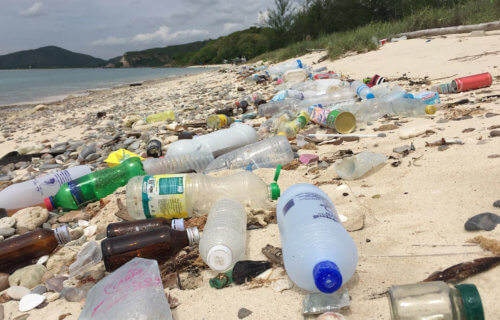LAWRENCE, Kan. — Plenty of people are fearing fungi more than ever nowadays thanks to HBO’s new hit show “The Last of Us.” While a mutated fungus might bring about the end of the world in fiction, here in reality fungi just might help save our planet. Ongoing research by a team at the University of Kansas is successfully transforming tough-to-recycle plastic waste in the Pacific Ocean into key ingredients in prescription drugs.
So, what’s the secret to this ocean-cleaning, chemical–biological approach for the conversion of polyethylene plastic? Researchers say it’s a genetically-altered version of an everyday soil fungus called Aspergillus nidulans.
“What we’ve done in this paper is to first digest polyethylenes using oxygen and some metal catalysts — things that are not particularly harmful or expensive — and this breaks the plastics into diacids,” says study co-author Berl Oakley, the Irving S. Johnson Distinguished Professor of Molecular Biology, in a university release.
Then, researchers fed long chains of carbon atoms produced by the decomposed plastics to genetically modified Aspergillus fungi. As intended, the fungi metabolized them into an array of pharmacologically active compounds. More specifically, the compounds included commercially viable amounts of asperbenzaldehyde, citreoviridin, and mutilin.
Unlike previous approaches, Prof. Oakley adds the fungi digested the plastic products very quickly, almost like “fast food.”
“The thing that’s different about this approach is it’s two things — it’s chemical, and it’s fungal,” the researcher continues. “But it’s also relatively fast. With a lot of these attempts, the fungus can digest the material, but it takes months because the plastics are so hard to break down. But this breaks the plastics down fast. Within a week you can have the final product.”

The new fungal approach is ‘bizarrely’ efficient
“Of the mass of diacids that goes into the culture, 42% comes back as the final compound,” Oakley says. “If our technique was a car, it would be doing 200 miles per hour, getting 60 miles per gallon, and would run on reclaimed cooking oil.”
Prof. Oakley has previously worked with corresponding author Clay Wang of the University of Southern California to produce roughly a hundred secondary metabolites of fungi for a variety of purposes.
“It turns out that fungi make a lot of chemical compounds, and they are useful to the fungus in that they inhibit the growth of other organisms — penicillin is the canonical example,” the professor notes. “These compounds aren’t required for the growth of the organism, but they help either protect it from, or compete with, other organisms.”
For a long period, scientists largely believed that they had fully exploited the potential of fungi to produce such compounds. However, Prof. Oakley believes the age of genome sequencing has unlocked tons of new possibilities for using secondary metabolites to benefit both humanity and the environment.
“There was a realization there were lots and lots of clusters of genes that made secondary metabolites that nobody had discovered — and there are millions of species of fungi,” Prof. Oakley says. “A lot of companies have done good work over the years, but it was very much incomplete, because they were just growing things in the incubator and examining them for production of new compounds — but 95 percent of the gene clusters were just silent since they are not ‘turned on’ until needed. They weren’t doing anything. So, there are lots more things to discover.”
Scientists are altering fungi on a genetic level
Prof. Oakley’s lab at KU has also honed gene-targeting procedures aimed at changing the expression of genes in Aspergillus nidulans, as well as other fungi, to produce new compounds.
“We’ve sequenced the genomes of a bunch of fungi now, and we can recognize the signatures of groups of genes that make chemical compounds,” the researcher explains. “We can change the expression of genes; we can remove them from the genome; we can do all kinds of things to them. We could see there were lots of these secondary metabolite gene clusters there and our gene-targeting procedures allowed us, at least in principle, to turn some of those clusters on.”
The research team primarily focused on creating secondary metabolites to digest polyethylene plastics. Why? Those plastics are especially hard to recycle. The team used polyethylenes taken from the Pacific Ocean near Catalina Harbor on Santa Catalina Island, California for this study.
“There’ve been a lot of attempts to recycle plastic, and some of it is recycled,” Oakley adds. “A lot of it is basically melted and spun into fabric and goes into various other plastic things. Polyethylenes are not recycled so much, even though they’re a major plastic.”
All plastic waste could become food for fungi
Prof. Oakley notes the long-term goal of this research is to develop procedures for breaking down all plastics into products that can be used as food by fungi. Crucially, this would eliminate the need to sort them during recycling.
“I think everybody knows that plastics are a problem,” Prof. Oakley concludes. “They’re accumulating in our environment. There’s a big area in the North Pacific where they tend to accumulate. But also you see plastic bags blowing around — they’re in the rivers and stuck in the trees. The squirrels around my house have even learned to line their nest with plastic bags. One thing that’s needed is to somehow get rid of the plastic economically, and if one can make something useful from it at a reasonable price, then that makes it more economically viable.”
The study is published in Angewandte Chemie, a journal of the German Chemical Society.

